Just like the software engineering community, product managers have access to lots of resources to support their development; from Slack groups and meet-ups to YouTube videos and newsletters.
But for those who love old-school content, there is a huge number of books available that cover all aspects of product management.
These books were written during the dawn of product management as a profession, and their authors count themselves among the real pioneers of the industry. No matter where you are in your product management career, you can learn a lot from the perspectives of those who have shaped the way product teams work.
Table of contents
- Inspired: How to Create Tech Products Customers Love, by Marty Cagan
- Lean Analytics: Use Data to Build a Better Startup Faster, by Alistair Croll and Benjamin Yoskovitz
- Thinking In Bets: Making Smarter Decisions When You Don’t Have All the Facts, by Annie Duke
- User Story Mapping: Discover the Whole Story, Build the Right Product, by Jeff Patton
- UX for Lean Startups: Faster, Smarter User Experience Research and Design, by Laura Klein
- The Lean Product Playbook: How to Innovate with Minimum Viable Products and Rapid Customer Feedback, by Dan Olsen
- Empowered: Ordinary People, Extraordinary Products, by Marty Cagan and Chris Jones
- Cracking the PM Interview: How to Land a Product Manager Job in Technology, by Gayle Laakmann McDowell and Jackie Bavaro
Inspired: How to Create Tech Products Customers Love, by Marty Cagan
Marty Cagan is the godfather of product management, and Inspired is its effective bible. The book covers a wide range of PM topics, such as how to structure and staff your product organization and how to deliver technology products that your customers will love.
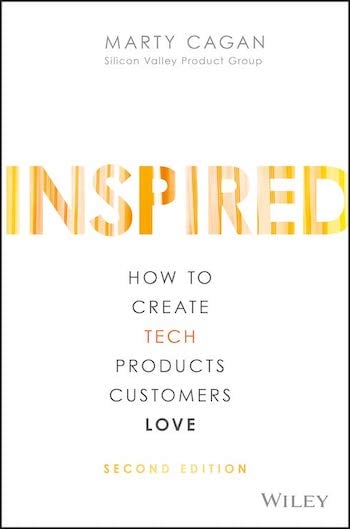
For those just starting out in product management, Inspired is a great resource to help you get familiar with the industry. It does a great job of setting the scene for how a product manager fits within an organization.
The first seven chapters of the book demonstrate how good product management impacts business success by telling stories of successful product organizations and the people key to their success.
By chapter 8, Cagan starts to look at the core concepts of product management, including product discovery, prototyping, delivery, market fit, and vision. As you move through the book from there, you start to understand how product teams are structured, what each individual role (product manager, designer, engineer, marketer, researcher, data analyst, etc…) should be looking to achieve, and how the roles interact.
The final sections of the book look into specific techniques for approaching the tasks of the product manager.
With all of this information contained within one book, it’s easy to see why Inspired is considered to be the blueprint for product management. It’s an essential read for all product professionals.
Lean Analytics: Use Data to Build a Better Startup Faster, by Alistair Croll and Benjamin Yoskovitz
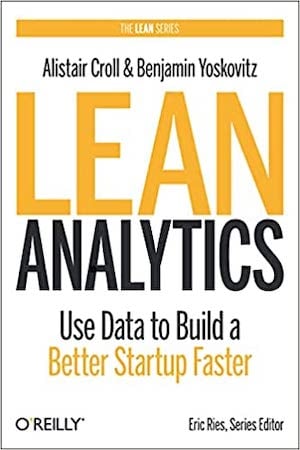
Marty Cagan himself recommends reading Lean Analytics, and given his guidance on the importance of product metrics, it is easy to understand why.
The authors, Alistair Croll and Benjamin Yoskovitz, are entrepreneurs with great track records. They pooled their experience, along with hundreds of interviews with business founders and investors, to come up with a guide for how to determine what should be measured and how to go about it.
The book is split into 31 chapters over four parts that cover:
- What analytics are
- What it means to take a lean approach
- How to create a framework for your analysis
- How to apply this framework within your organization
As a product manager, whenever you start a new role, your first task is to determine what metrics are most important to your organization (e.g., retention, engagement, etc.) and how the organization is measuring them. Lean Analytics is a great place to start if you’re looking to jump-start the way your company collects and uses data. After all, you can only make a successful product when you know what success looks like and whether you’re achieving it.
Thinking In Bets: Making Smarter Decisions When You Don’t Have All the Facts by Annie Duke
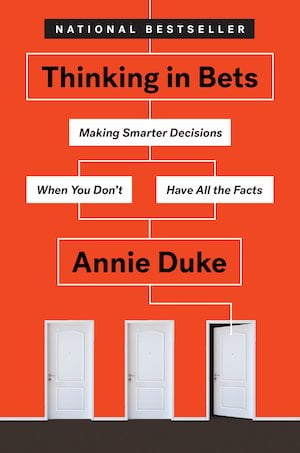
Of course, even with all the data in the world, you still won’t know all the factors that are influencing what’s happening in your product. Sometimes, there is information that is hidden from view and you need to use some judgment on how to proceed.
According to Annie Duke, author of Thinking In Bets, the key to long-term success when dealing with this kind of esoteric data is to think in terms of bets. For example:
- How sure am I about what is being decided?
- What are all the possible ways in which it could turn out?
- Which decision has the highest odds of success?
- Did I land in the unlucky 10 percent on a strategy that works 90 percent of the time?
- Or, is my success attributable to dumb luck rather than great decision-making?
There’s a section in chapter 2 titled “All decisions are bets.” I think this phrase really sums up the point that Duke is trying to make.
If you need to improve the conversion rate of your e-commerce basket, for example, what would you put your money on? How confident are you that you’d be taking home some winnings and not worrying about your losses? Prioritize the bets you’re most confident in.
What does Annie Duke know about thinking in bets, you might ask? She just so happens to be a former World Series of Poker champion!
User Story Mapping: Discover the Whole Story, Build the Right Product, by Jeff Patton
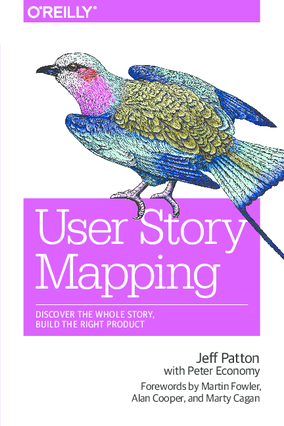 Once you’ve picked your bet, the next step is to write up the work for the engineering team to deliver. That’s where the user story comes in.
Once you’ve picked your bet, the next step is to write up the work for the engineering team to deliver. That’s where the user story comes in.
Jeff Patton is the founder and principal of Jeff Patton & Associates, having been involved in creating software since the 1980s. In the late 1990s and early 2000s, he worked as a product leader for what was grown into Salesforce Commerce Cloud — so he knows a thing or two about delivering great products.
In User Story Mapping: Discover the Whole Story, Build the Right Product, Patton examines how the technique of mapping out your user stories can help your team stay focused on users and their needs without getting lost in the enthusiasm for individual product features.
The act of mapping your user stories follows five rough areas:
- Framing — creating a short feature brief that sets the boundaries of what you are going to map
- Mapping — evaluating the whole feature story, looking to the edges of the frame, but not very deep within it
- Exploring — filling in the detail of the story map, diving down into the high-level mapped features and breaking them down into smaller chunks
- Slicing for releases — grouping user stories that, when delivered together, allow you to have a viable product release
- Slicing for strategic development — taking your release slice and breaking into a few delivery phases, which allows you to reduce risk and learn quickly
It’s great advice for any product manager to maintain focus on what’s important for their users.
UX for Lean Startups: Faster, Smarter User Experience Research and Design, by Laura Klein
 Laura Klein has over 20 years of product and user experience, and her expertise shines in UX for Lean Startups. Klein examines the principles of a great user experience and demonstrates how you can achieve them without having to follow a lengthy and expensive UX process.
Laura Klein has over 20 years of product and user experience, and her expertise shines in UX for Lean Startups. Klein examines the principles of a great user experience and demonstrates how you can achieve them without having to follow a lengthy and expensive UX process.
The key principles focus on formulating and validating your user hypothesis, then doing the same with the ideas you generate before you even start designing your product. This circle of hypothesis, idea, and validation helps you ensure you’re building only the right things for the right people at the right time.
If you’re new to product, UX for Lean Startups will help you learn how to user-test your products. Even if you’re a seasoned PM, it’ll help you learn how to user-test better.
The Lean Product Playbook: How to Innovate with Minimum Viable Products and Rapid Customer Feedback, by Dan Olsen
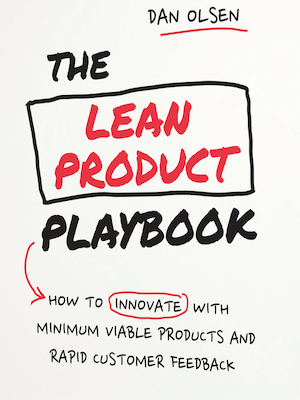 The Lean Product Playbook is a practical guide to building products that customers love. It doesn’t matter whether you work at a startup or a large, established company; building great products is hard.
The Lean Product Playbook is a practical guide to building products that customers love. It doesn’t matter whether you work at a startup or a large, established company; building great products is hard.
Most new products fail, and even established products have failures in their history. In this book, Dan Olsen looks to help you improve your chances of building successful products through clear, step-by-step guidance and advice.
Split into three parts, the playbook takes a look at the:
- Core concepts of product-market fit — Are customers buying and using the company’s products in numbers large enough to make the business profitable?
- Lean product process — identifying your customers, defining your value proposition, determining your MVP
- Steps beyond your MVP — e.g., agile development, key metrics, optimization, etc.
For those in many product management roles, you aren’t actually spending much time creating brand new products. Instead, you’re focused on making iterative improvements to existing products. The principles of the lean product playbook hold true for progressive product change.
Empowered: Ordinary People, Extraordinary Products, by Marty Cagan and Chris Jones
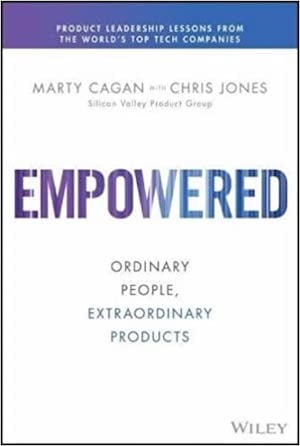 If Inspired looked at the blueprint for organizational product management, Empowered is designed to provide you, as a leader of product management, product design, or engineering, with everything you need to set up your team for product greatness.
If Inspired looked at the blueprint for organizational product management, Empowered is designed to provide you, as a leader of product management, product design, or engineering, with everything you need to set up your team for product greatness.
The book covers:
- What it means to be an empowered product team, and how this is different from the “feature teams” most companies use to build technology products
- Recruiting and coaching the members of product teams — first to competence, and then to reach their potential
- Creating an inspiring product vision, along with an insights-driven product strategy, and translating that strategy into action by empowering teams with specific objectives-problems for solve rather than features to build
- Redefining the relationship between product and the rest of the company
- Detailing the changes necessary to effectively and successfully transform your organization into truly empowered product teams
As you can see, Empowered is aimed at more senior product managers — specifically, PMs who manage teams. But that doesn’t mean newcomers can’t take something from this book because it gives clear guidance on what you should aim for and why you should be doing it.
Cracking the PM Interview: How to Land a Product Manager Job in Technology, by Gayle Laakmann McDowell and Jackie Bavaro
 Of course, before you can apply all the great advice from the experts in the books mentioned above, you need to be successful in a product management interview.
Of course, before you can apply all the great advice from the experts in the books mentioned above, you need to be successful in a product management interview.
When you’re in an interview, you’ll get a mix of the standard interview questions (e.g., “Tell me about your greatest achievement,” “Why are you looking for a new role?” etc.) and product-specific questions. In Cracking the PM Interview, the authors look at both sets of questions and offer advice on how to handle them.
Product management interviews are renowned for having some challenging questions, particularly around estimation, that provide great insight into how you think about product problems. For example:
- How many pizzas are delivered in Manhattan?
- How do you design an alarm clock for the blind?
- How would you launch a video rental service in India?
With a few examples, this book helps you understand how you can approach any question of this type, even if you don’t know where Manhattan is or have never seen a VHS tape.
In addition to the interview-specific details, the book also looks at product careers in general, comparing product roles among some of the world’s most recognizable brands and sharing career advice from leading product experts.
What next?
All product people are busy, but if you can find time to tick off one of these books a month, you’ll soon be in possession of some of the key skills needed for a successful product career — delivered directly from those who have shaped the way in which product management is performed around the world.
The post 8 product management books that should be on every PM’s shelf appeared first on LogRocket Blog.
from LogRocket Blog https://ift.tt/weFV6Tc
Gain $200 in a week
via Read more



